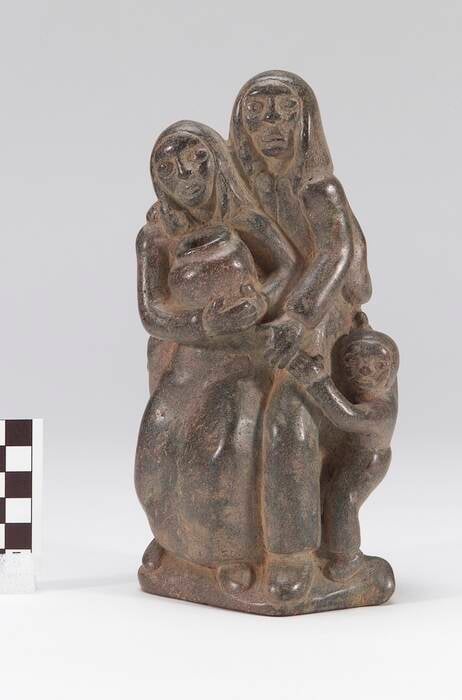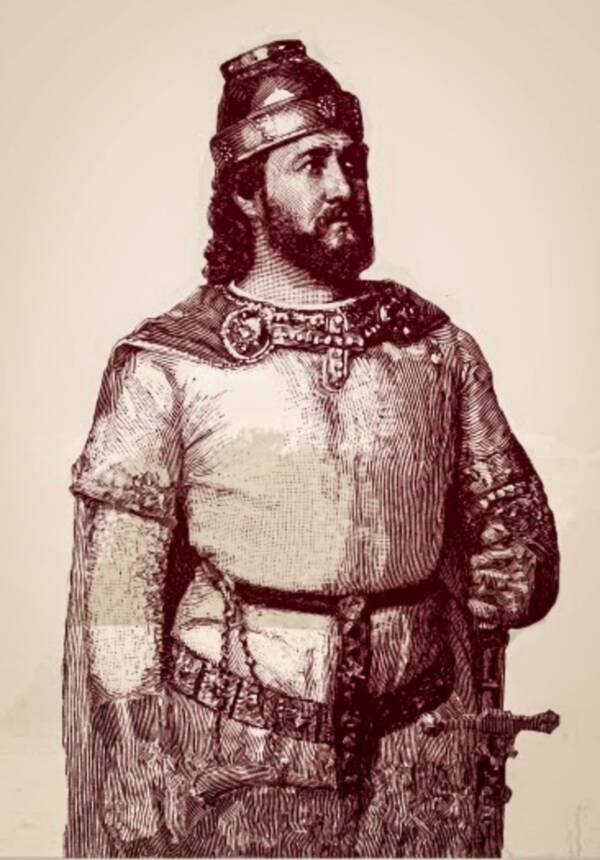Is the legend of the Moon-Eyed people proof that Welsh explorers landed in America more than 300 years before Columbus?
Cherokee legend is full of incredible tales. But one of the most fantastic — and intriguing — stories concerns the moon-eyed people.
According to Cherokee lore, moon-eyed people lived deep in the woods of present-day North Carolina and Georgia. Blue-eyed and pale, they were so sensitive to light that they slept during the day and emerged only in the moonlight. And unlike other beings who appear in Indigenous legends, they were neither spirits nor monsters but humans like the Cherokee themselves.

National Museum of the American IndianA modern rendering of moon-eyed people by a Cherokee artist.
Though the legend of the moon-eyed people may be merely that — legend — some suspect that Cherokee stories about these mysterious beings may be rooted in historical fact. Some even suspect that the moon-eyed people were descendants of Welsh settlers who arrived centuries before Christopher Columbus.
This is the story of the moon-eyed people of the Appalachians and the mysterious traces that they may have left behind.
The Legend Of The Moon-Eyed People
As European settlers poured into North America in the 18th century, they began documenting the legend of the moon-eyed people for the first time. According to Legends of America, the Cherokee described this mysterious race of people as small, light-eyed, and pale. Because of their sensitivity to light, they hid during the day and emerged only at night.
“[T]he Cheerake tell us, that when they first arrived in the country which they inhabit, they found it possessed by certain ‘moon-eyed-people,’ who could not see in the day-time,” American botanist and educator Benjamin Smith Burton wrote in 1797.
A Cherokee chief, Oconostota, also recounted the story of the moon-eyed people to Tennessee governor John Sevier in 1782. An old man at the time, Oconostota repeated the story told to him by his ancestors, that “white men” had long ago “crossed the great water [the Atlantic Ocean] and landed first near the mouth of the Alabama River near Mobile.”

Tennessee State Library And ArchivesA depiction of Oconostota, the Cherokee chief who told stories about the moon-eyed people.
So, what happened to the moon-eyed people?
Burton recorded that the Cherokee had “expelled” “these wretches.” And North Carolina Ghosts suggests that the Cherokee took advantage of the moon-eyed people’s intolerance for brightness by attacking them during a powerful full moon.
Today, it’s possible to see tales of moon-eyed people as mere myths. But some believe that the moon-eyed people really existed. They suspect that they were Europeans who came to North America in the 12th century.
Did Welshmen Come To North America In 1170?
The legend of the moon-eyed people runs parallel to another legend, this one about a Welsh prince named Madoc ab Owain Gwynedd. Madoc and his brother Rhirid allegedly decided to flee from Wales in 1170 because of a civil war between their brothers.
Sailing west, the brothers allegedly landed in North America and established a settlement. Legend states that Madoc even returned to Wales to bring more people across the Atlantic with him. And though Madoc and Rhirid subsequently disappeared from the historical record, their story was kept alive from the 12th century onward through Welsh stories and songs.

Dictionary of Canadian BiographyA depiction of Madoc ab Owain Gwynedd.
So, were these Welsh princes ancestors of the moon-eyed people?
Oconostota apparently thought so. He told Sevier that mysterious mounds in the area had been built by Welshmen. What’s more, some Welsh settlers noticed startling similarities between their culture and the indigenous culture they encountered in the New World.
Welshmen in North America found stone forts like those their ancestors had built back in Wales, noticed that some Indigenous people had pale skin and blue eyes, and even remarked that certain Indigenous languages sounded similar to Welsh.
In 1608, a group of white settlers even found that Welsh was so similar to the Monacan’s language that they had a Welsh-speaking member of their party, Peter Wynne, act as an interpreter between the two groups.
Though it’s easy to dismiss some of this evidence as coincidence, some contend that the moon-eyed people also left physical traces of their civilization in the Appalachians.
Mysterious Traces Of Moon-Eyed People
To this day, a number of strange sites exist across the Appalachian foothills which some believe are traces of the moon-eyed people. As Legends of America notes, one such site is Fort Mountain in Georgia.
There, crumbling traces remain of a once-mighty wall. Almost 900 feet long, 12 feet thick, and seven feet high in some places, the wall bears a striking resemblance to European battlements.
Sevier even told a friend that the wall had been built by “the Welsh,” writing that they’d constructed it “as protection against the ancestors of the Cherokee, who eventually drove them from the region.”

Thomsonmg2000/Wikimedia CommonsThe remains of the crumbling wall on Fort Mountain in Georgia.
But if the wall on Fort Mountain was built by the moon-eyed people, the “Welsh,” they may not have had anything to do with the two 12th-century princes. Some historians have estimated that the wall predates their arrival by hundreds of years, and may have been built between 400 and 500 C.E.
A local history museum in Murphy, North Carolina, also claims to have a moon-eyed people artifact. They contend that a 19th-century farmer dug up a strange statue on his land, which appears to depict two people, either standing close together or conjoined, with flat faces.

A statue that appears to depict moon-eyed people on display at the Cherokee County Historical Museum.
Whether or not this statue depicts the moon-eyed people — or if it was made by them — is unclear, however.
In the end, the legend of the moon-eyed people leaves historians with more questions than answers. Were Cherokee stories about the pale, light-eyed people who hated sunlight mere myth? Or did they point to some, unknown historic truth? Were moon-eyed people Welsh? Or something different?
For now, the answers appear lost to time. But local lore states that along certain portions of the crumbling wall on Fort Mountain, you can still hear distant drumbeats and catch glimpses of men in bearskins. Perhaps these are distant echoes of the mysterious moon-eyed people.
For more on lost civilizations, check out the story of the Roanoke Colony. Then, read up on six bizarre and interesting events you probably didn’t learn about in history class.






